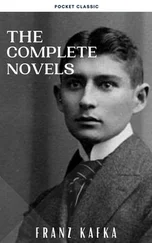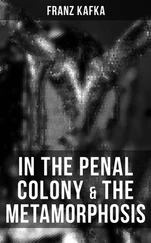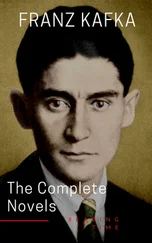Kafka truly became Kafka when—between 1912 and 1914—to anguished poetic narration he added fear and horror. Begun in 1911, “The Stoker” (the first chapter of Amerika ), which was awarded a literary prize in 1915, expressed tenderness and grief in an atmosphere which was at once realistic and extravagant. But was Kafka aware of this? He invoked Dickens as his model and entertained the notion of writing a new David Copperfield .
Between 1912 and 1914 his intentions, though quite different, are clear. In “The Metamorphosis” and “In the Penal Colony” as well as in “The Judgment,” all produced during this period, we no longer find the realism—the imaginative, fantastic, picaresque details tinged with melancholy—of Amerika , nor even the uncanny qualities of the disordered episodes in “Description of a Struggle.” What we find is something more cruel and sadistic than anything in the later myths of The Trial and The Castle —horror experienced as such, or even, putting it another way, horror limited to horror. We would be close to the “tale of horror” or “frenzied romanticism” if the method of achieving tone and style did not eliminate any feeling of complaisance.
Everything in “The Metamorphosis” is well balanced and quite commonplace, and it is without the slightest warning, without the slightest nod to the reader, that the author develops the story of Gregor Samsa who, as he “awoke one morning from uneasy dreams … found himself transformed in his bed into a gigantic insect.” In the presence of a man who has been changed into a vermin, the family is upset, but not really any more so than if the man had had bronchitis. And the first part of the story is devoted in its entirety to the difficulty experienced by Gregor, a commercial traveler, in making the General Manager of his firm understand that he is no longer in a position to visit businessmen in neighboring towns.… Does he suffer from his transformation into a repulsive insect? Kafka is careful not to reveal the answer. He diverts attention from whatever might be scandalous and revolting. Gregor should begin to scream, to think that he has gone mad, but he does not. He concentrates on how he, with his numerous clumsy legs and his inflexible shell, can move about: “He set himself to rocking his whole body at once so that he could swing out of bed. In this way he could protect his head from injury by holding it up as he fell.” His sister comes in calmly to clean the multiped’s room. His mother seems completely crushed, his father takes precautions to keep the neighbors from learning what has happened.
Thus the lack of realism is not proclaimed, not called to our attention, not emphasized. It is felt and accepted as naturally as humble people accept misfortunes. And it is for this reason that it becomes atrocious.
Here atrocity means only sadness—unfathomable sadness. When this multiped dies in its room, the maid touches it with her broom: “Mrs. Samsa made a movement as if to stop her, but checked it. ‘Well,’ said Mr. Samsa, ‘we can thank God.’ He crossed himself, and the three women followed his example.” Later the maid comes in and says, “You need not bother about how to get rid of the thing in there. It has been done already.…”
Similarly, only the author’s restrained, scrupulous artistry enables us to accept the sadistic tale “In the Penal Colony,” which describes a penitentiary in which the condemned are severely punished for the slightest mistake. An officer shows a traveler who has been invited to visit the penitentiary the Machine used to punish the prisioners. This precisely engineered machinery, described seriously and in detail through several pages, is designed to imprint on the skin of the culprit the commandment which he has broken. The needles of the machine communicate the guilt of the accused to him by engraving the same sentence in his flesh, deeper and deeper always, for six hours. Jets of water and layers of cotton wool are provided for washing and sponging wounds, as well as outlets for the blood and water. The Machine is automatic; at the sixth hour, the condemned man generally begins to die.
Here minutiae heighten the sense of atrocity. Still, not a single expression or word betrays complaisance. Kafka does not delight in sadistic creations of the imagination; patiently he constructs the mechanisms of sadism, but he does not allow the mechanism to overpower him or invite the reader to participate in it; finally, the torture machine goes to pieces, and the only effect of the patient, disquieting tale is an immense sadness, without grief and without pity.…
These narratives overawe us not only because of their unnerving character but also because of their consummate artistry. To be sure, in “The Metamorphosis” we find diabolical meanings of every sort: of the powerlessness and loneliness of the individual who, when he becomes aware of the hypocrisy of his existence, feels himself transformed into a hideous object, condemned to the barren death of an insect. But a symbol is inadequate. Though unexpressed, it is all too visible and easy; it would not become significant without the somber, well measured art that transforms it into a legend.
Thousands of men whose hearts and minds were tortured have been able to imagine Kafkan myths, have proclaimed them loudly or expressed them lyrically, yet have been misunderstood or even mistaken for fools. Kafka’s imagination verges on madness, but a law of sobriety or consummate art dominates his writing.
This art is the product of a calculated attempt to express the improbable as if it were real—to describe it in minute detail. Even in his Diary and his first sketches, Kafka was accustomed conscientiously to record insignificant details, gestures, attitudes.
When my superior discusses routine matters with me (today it was the card-index), I am unable to look him in the eye for any length of time without showing, in spite of my best efforts, a trace of bitterness which causes his gaze or mine to shift.… So I resort to a more active defense and accelerate the zigzags of my own look, preferring to consider the line of his nose, his beard, and his cheeks.… 2
The penchant for precision and the pattern of dwelling on details and commenting on them confer on the fantastic narrative a harsh impression of reality. The result is a nightmare, but a nightmare so exact it conveys the feeling of something lived through, as in the dream recorded by Kafka in 1911. In this dream he moved through a number of rooms.
Perhaps I was going through a series of bedrooms. I remember a typical bed which stood on one side, to my left, against a sloping wall, as in an attic; dark or dirty, it had on top of it a low pile of sheets and bedspread which seemed to be only a heavy linen sheet and which tapered downward to the floor … 3
Inherent in this apparently ingenuous precision is the difference between a dream in which one believes and a dream in which one does not believe. Kafka’s painstaking description seems to prefigure far in advance the “anti-novel” school of French writers which came into existence around 1956, for even to report a dream, he practices exact delineation in minute detail.
To the left there was a full wall while to the right the wall was not complete: one could glimpse, down below, the court, although one could not see the bottom, toward which a gray, dilapidated stairway led by way of different landings.
Paradoxically, this attentiveness to objects or things only reinforces the impression of penetrating into a consciousness. The explanation is that we then participate in the petty activities of a consciousness which busies itself with seeing things.
If Joseph K. is strikingly real in The Trial , this is because he is thinking not of his trial but of passageways, a door, the manner of opening a door. Furthermore, no Kafkan text reveals to us the soul of the hero or the feelings that he ought to have, but only his mind occupied by the things that surround him or by a thousand trivial designs. Kafka gives us the sensation of psychological life by speaking not of psychological life but of the objects by which it is aroused.
Читать дальше












